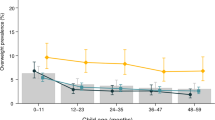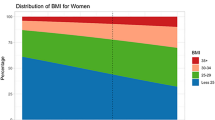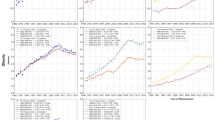Abstract
The objective was to analyze the situation in Switzerland regarding the prevalence of overweight or obesity in children, adolescents and adults. The data were compared with France, an adjacent much larger country. The results showed that there is a definitive lack of objective information in Switzerland on the prevalence of obesity at different ages. As in other European studies, the fact that many national surveys are classically based on subject interviews (self-reported weights and heights rather than measured values) implies that the overweight/obesity prevalence is largely underestimated in adulthood. For example, in a recent Swiss epidemiological study, the prevalence of obesity (BMI greater than 30 kg/m2) averaged 6–7% in young men and women (25–34 y), the prevalence being underestimated by a factor of two to three when body weight was self-reported rather than measured. This phenomenon has already been observed in previous European studies. It is concluded that National Surveys based on telephone interviews generally produce biased obesity prevalence results, although the direction of the changes in prevalence of obesity and its evolution with repeated surveys using strict standardized methodology may be evaluated correctly. Therefore, these surveys should be complemented by large-scale epidemiological studies (based on measured anthropomeric variables rather than declared) covering the different linguistic areas of Switzerland. An epidemiological body weight (BMI) monitoring surveillance system, using a harmonized methodology among European countries, would help to accurately assess differences in obesity prevalence across Europe without methodological bias. It will permit monitoring of the dynamic evolution of obesity prevalence as well as the development of appropriate strategies (taking into account the specificity of each country) for obesity prevention and treatment.
This is a preview of subscription content, access via your institution
Access options
Subscribe to this journal
Receive 12 print issues and online access
$259.00 per year
only $21.58 per issue
Buy this article
- Purchase on Springer Link
- Instant access to full article PDF
Prices may be subject to local taxes which are calculated during checkout
Similar content being viewed by others
Author information
Authors and Affiliations
Corresponding author
Rights and permissions
About this article
Cite this article
Schutz, Y., Woringer, V. Obesity in Switzerland: a critical assessment of prevalence in children and adults. Int J Obes 26 (Suppl 2), S3–S11 (2002). https://doi.org/10.1038/sj.ijo.0802122
Published:
Issue Date:
DOI: https://doi.org/10.1038/sj.ijo.0802122
Keywords
This article is cited by
-
Body Mass Index and risk for onset of mood and anxiety disorders in the general population: Results from the Netherlands Mental Health Survey and Incidence Study-2 (NEMESIS-2)
BMC Psychiatry (2022)
-
BMI distribution/social stratification in Swiss conscripts from 1875 to present
European Journal of Clinical Nutrition (2010)
-
Change of individual BMI in Switzerland and the USA: a multilevel model for growth
International Journal of Public Health (2010)
-
Prevalence of overweight in 6- to 15-year-old children in central/western France from 1996 to 2006: trends toward stabilization
International Journal of Obesity (2009)
-
ADOS: an educational primary prevention programme for preventing excess body weight in adolescents
International Journal of Obesity (2008)



